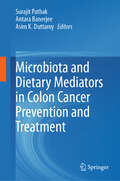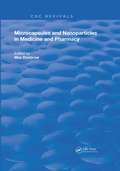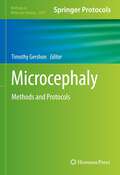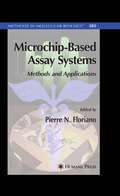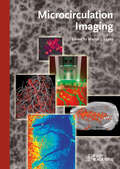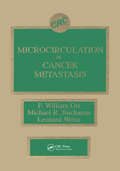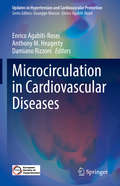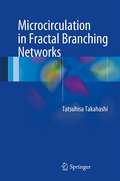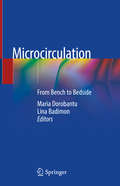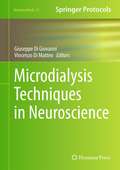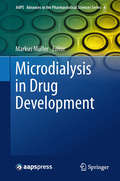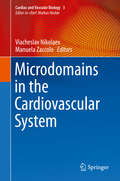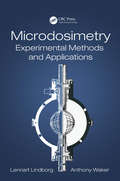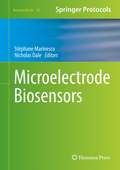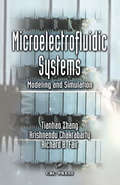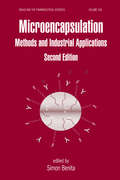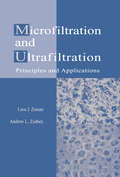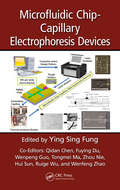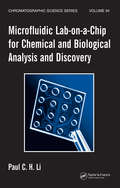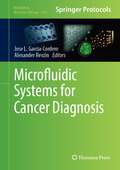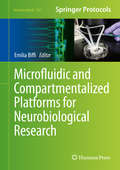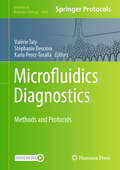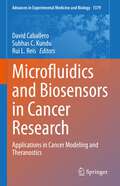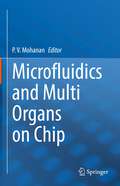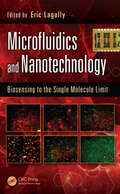- Table View
- List View
Microbiota and Dietary Mediators in Colon Cancer Prevention and Treatment
by Asim K. Duttaroy Surajit Pathak Antara BanerjeeThe book discusses the role of gut microbiome composition in colorectal cancer progression, linking intestinal inflammation, tumorigenesis and anti-cancer immune responses. Chapters delve into various areas, including the mechanisms of action of probiotics and prebiotics (such as Lactobacillus and Bifidobacterium strains, and fructans and galactans, respectively), functional foods such as α-carotene, β-carotene, lutein, β-cryptoxanthin, fucoxanthin, isothiocyanates, flavonoids, probiotics, fibre and omega-3. Lycopene, β-cryptoxanthin, and fucoxanthin. Dietary phytochemicals such as polyphenols (curcumin, gingerol, ferulic acid (FA) and hydroxytyrosol); alkaloids (piperine, and protopine); terpenoids (artemisinin, and astaxanthin); iridoid glycoside (picroside II, and morroniside); and flavonoid (quercetin) on cancer, immune responses, and the gut microbiome. It examines the interaction and influence of prebiotics and probiotics in colorectal cancer treatment, their use in managing chemotherapy-related gastrointestinal problems, and their potential as adjuvants. The book also investigates how these gut microbes are associated with tumor progression and anti-cancer treatment efficacy. This knowledge can be used to develop biomarkers that predict immunotherapy effectiveness and improve treatment outcomes through modulation. This book provides a comprehensive update on the latest research and clinical applications in the field, offering valuable insights into the complex interplay between probiotics, the gut microbiome, and colorectal cancer. It serves as an invaluable resource for healthcare professionals, researchers, and students seeking to understand this dynamic area of study.
Microcapsules and Nanoparticles in Medicine and Pharmacy (Routledge Revivals)
by D. Sc. Max DonbrowFirst published in 1992: This book provides a comprehensive look at the design and production of microcapsules, microspheres, and nanoparticles. It discusses the diverse aspects and skills that must be mastered to prepare and test products that will work correctly and be clinically acceptable for human or animal use.
Microcephaly: Methods and Protocols (Methods in Molecular Biology #2583)
by Timothy GershonThis volume discusses the latest imaging and molecular techniques for studying microcephaly through neural progenitor proliferation, survival, and gene expression. All of the methods covered in this book use the mouse as a model system, and include cellular, metabolic, transcriptomic studies of neural progenitors, MR imaging studies of brain growth in 3-dimensions and developmentally-adapted studies of behavior in neonatal mice. Written in the highly successful Methods in Molecular Biology series format, chapters include introductions to their respective topics, lists of the necessary materials and reagents, step-by-step, readily reproducible laboratory protocols, and tips on troubleshooting and avoiding known pitfalls. Cutting-edge and comprehensive, Microcephaly: Methods and Protocols is a valuable resource for all researchers who want to expand their knowledge and understanding of this important and developing field.
Microchip-Based Assay Systems
by Pierre N. FlorianoThis cutting-edge book explores recent progress in the microelectronics arena. It examines the resultant miniaturization of component device features to nanometer size particles, and the ensuing growth in the development and use of microchip-based techniques in leading laboratories around the world. In the sixteen chapters of this volume, leading scientists present technically precise microchip-based assays for a variety of applications.
Microcirculation Imaging
by Martin J. LeahyAdopting a multidisciplinary approach with input from physicists, researchers and medical professionals, this is the first book to introduce many different technical approaches for the visualization of microcirculation, including laser Doppler and laser speckle, optical coherence tomography and photo-acoustic tomography. It covers everything from basic research to medical applications, providing the technical details while also outlining the respective strengths and weaknesses of each imaging technique. Edited by an international team of top experts, this is the ultimate handbook for every clinician and researcher relying on microcirculation imaging.
Microcirculation in Cancer Metastasis
by F. William Orr Michael R. Buchanan Leonard WeissAlthough mechanisms involved in the spread of cancer have been the subject of a major research endeavor over the past decade, metastatic tumors still account for significant clinical morbidity and the failure of cancer treatment. Not only are the vascular pathways the most common route for the dissemination of cancer cells, but interactions between the cells and the circulation act as important rate-regulators for the metastatic process.This authoritative, multi-authored volume addresses the importance of microcirculation in cancer metastasis. The book begins with up-to-date reviews on the biology of endothelial cells and the structure and physiology of the normal and tumor microcirculations, and then emphasizes interactions between components of the microcirculation and cancer cells. Metastasis is discussed through chapters exploring the entry of cancer cells into the circulation, the biophysics and morphology of cancer cell traffic and arrest, interactions with host cells and the basement membranes, and angiogenesis. This fascinating book will interest oncologists, pathologists, and students of metastasis or the microcirculation.
Microcirculation in Cardiovascular Diseases (Updates in Hypertension and Cardiovascular Protection)
by Anthony M. Heagerty Enrico Agabiti-Rosei Damiano RizzoniThis book offers an extensive review of the most recent data on the pathophysiological role of structural and functional alterations in the microcirculation, particularly focusing on hypertension and diabetes. It covers several relevant and innovative aspects, including the possible mechanisms involved in the development of microvascular remodeling and rarefaction, the technical approaches available for the detection of microvascular alterations, including non-invasive evaluations, the prognostic role of changes in small resistance artery structure, the possibility of preventing or regressing such alterations with appropriate treatment, and the potential clinical advantages of such intervention. A number of innovative areas of research are considered, including the role of the immune system, inflammation and oxidative stress in the development of microvascular alterations. Lastly, it examines the availability of recent non-invasive methods for the evaluation of small resistance artery morphology in the retina, which in the near future may provide a useful tool for the stratification of cardiovascular risk and even for clinical decisions regarding drug treatment, thus providing physicians with a clinically relevant instrument for improving and optimizing the management of hypertensive and diabetic patients. The book provides valuable, clinically relevant information for specialists (cardiology, internal medicine, and endocrinology) and general practitioners, and also offers novel and stimulating data to basic and clinical researchers.
Microcirculation in Fractal Branching Networks
by Tatsuhisa TakahashiThis book presents a new method for analyzing the structure and function of the biological branching systems of fractal trees, with a focus on microcirculation. Branching systems in humans (vascular and bronchial trees) and those in the natural world (plants, trees, and rivers) are characterized by a fractal nature. To date, fractal studies have tended to concentrate on fractal dimensions, which quantify the complexity of objects, but the applications for practical use have remained largely unexplored. This book breaks new ground with topics that include the human retinal microcirculatory network, oxygen consumption by vascular walls, the Fåhraeus-Lindqvist effect, the bifurcation exponent, and the asymmetrical microvascular network. Readers are provided with simple formulas to express functions and a simulation graph with in vivo data. The book also discusses the mechanisms regulating blood flow and pressure and how they are related to pathological changes in the human body. Researchers and clinicians alike will find valuable new insights in these pioneering studies.
Microcirculation: From Bench to Bedside
by Maria Dorobantu Lina BadimonThis comprehensive reference book of coronary microcirculation broadly covers theoretical aspects, clinical cases and therapeutic considerations from an innovative perspective. Topics covered include: ischemic heart disease, silent cerebral damage, heart failure, left ventricular hypertrophy arrhythmias, and cerebral and renal microcirculation.Microcirculation: From Bench to Bedside underlines the clinical importance of addressing coronary microcirculation with relevant clinical examples that are often encountered by practitioners. It therefore provides a critical resource on microcirculation for both specialist and non-specialist practitioners.
Microdialysis Techniques in Neuroscience
by Vincenzo Di Matteo Giuseppe Di GiovanniSince its first application, microdialysis has become incredibly popular to study brain function and has been applied with success in different fields from psychopharmacology, neurobiology, and physiology in animals and also humans. Microdialysis Techniques in Neuroscience focuses on the practical aspects of microdialysis in animal and human, highlighting current technical limitations and providing a vision of what is yet to come for the determination of the most disparate compounds in the brain. The book's contents range from new techniques for detection and quantifying the release of several different neurotransmitters in vitro and in vivo, even in freely moving animals, to sophisticated use of reverse dialysis and the application of microdialysis in pharmacokinetic studies. Each of the sixteen chapters, in fitting with the spirit of the Neuromethods series, contain an introduction that gives a broad overview of a focused topic, followed by an extensive protocol on how the experiments are performed along with invaluable practical advice. Detailed and authoritative, Microdialysis Techniques in Neuroscience will be a valuable reference for students, neuroscientists, and physicians for the use of microdialysis in the study of brain functions and its clinical applications.
Microdialysis in Drug Development
by Markus MüllerA vast number of diagnostic and therapeutic decisions are based on measuring blood concentrations of molecules, yet most biochemical and pharmacological events actually take place in the tissues. Microdialysis is a key semi-invasive sampling technique to measure in vivo drug penetration to the target site in humans, the method being feasible in virtually every organ. Authored by international experts in this cutting edge field, this book will provide a comprehensive overview of microdialysis and its application for measuring drug distribution in drug development.
Microdomains in the Cardiovascular System (Cardiac And Vascular Biology Ser. #4)
by Manuela Zaccolo Viacheslav NikolaevThe book comprehensively presents new findings in cardiovascular research related to signaling microdomains in health and disease. Important second messengers such as cAMP, cGMP, calcium and their role in microdomain signaling are discussed. The book offers and explains methodical approaches and technical ways how to successfully analyze microdomain signaling, also in the context of disease. It further provides scientific perspectives and strategies that are based on the concept of signaling within microdomains and that can revolutionize pharmacology and eventually lead to the effective treatment of cardiovascular diseases in future. This book is written for scientists in cardiovascular research, pharmacology, molecular and cellular biology as well as medical doctors in cardiology, angiology and nephrology.
Microdosimetry: Experimental Methods and Applications
by Anthony Waker Lennart LindborgExperimental microdosimetry deals with the measurement of charged particle energy deposition in tissue equivalent volumes, ranging in size from nanometres to micrometres. Microdosimetry is employed to improve our understanding of the relationship between radiation energy deposition, the resulting biological effects, and the appropriate quantities to be used in characterizing and quantifying radiation quality. Although many reviews and contributions to the field have been published over the past fifty years, this new book is the first to provide a single, up to date, and easily accessible account of experimental microdosimetry. This book is designed to be used in medical, radiation, and health physics courses and by Master’s and PhD students. In addition to serving as an introductory text to the field for graduate students, this book will also be of interest as a teaching and reference resource for graduate supervisors and established researchers. Drs. Lennart Lindborg and Anthony Waker have spent a life-time career in experimental microdosimetry research in academic, industrial and regulatory environments and have observed the development of the field from its early days as a recognized discipline; they bring to this book particular knowledge and experience in the design, construction, operation and use of tissue equivalent gas ionization counters and chambers.
Microelectrode Biosensors
by Stéphane Marinesco Nicholas DaleFor molecules that are not directly electroactive, it is necessary to modify a microelectrode by grafting polymeric or enzymatic membranes capable of translating a local concentration into an electrical current, which is a concept referred to as biosensing. In Microelectrode Biosensors, experts in the field cover the topic of electrochemical biosensor technology as applied to the neurosciences. The volume opens with a section addressing the specific issue of manufacturing biosensors that can be implanted in the central nervous system for neurotransmitter detection, and it then continues with sections on recent studies where biosensors have made a difference in bringing a new level of understanding of signaling mechanisms in neuroscience as well as recent developments in biosensor technology that have not yet been applied to implantable microelectrodes but may have great potential. Written for the Neuromethods series, this work contains the kind of detailed descriptions and implementation advice necessary to achieve successful results. Focused and cutting-edge, Microelectrode Biosensors serves to inspire the wider neuroscience and physiology community to adopt these powerful methods in their own applications in order to move the field forward with the widespread advances that will most likely flow from the adoption of biosensing as part of the standard laboratory toolkit.
Microelectrofluidic Systems: Modeling and Simulation (Nano- and Microscience, Engineering, Technology and Medicine)
by Tianhao Zhang Krishnendu Chakrabarty Richard B. FairComposite systems that integrate microelectromechanical and microelectrofluidic (MEF) components with electronics are emerging as the next generation of system-on-a-chip (SOC) designs. However, there remains a pressing need for a structured methodology for MEFS design automation, including modeling techniques and simulation and optimization tools. Integrating top-down and bottom-up design philosophies, Microelectrofluidic Systems presents the first comprehensive design strategy for MEFS. This strategy supports hierarchical modeling and simulation from the component level to the system level. It leads to multi-objective optimization tools valuable in all phases of the design process, from conceptualization to final manufacturing. The authors begin by defining the basic variables and elements needed to describe MEFS behavior, then model that behavior across three layers of abstraction: the low-level component, high-level reconfigurable architecture, and bio/chemical application layers. They have developed a hierarchical integrated design environment with SystemC and present its architecture and associated functional packages. Microelectrofluidic Systems is visionary in its leverage of electronic design principles for microsystem design and heralds a new era of automated SOC design. The strategy it presents holds the potential for significant reductions in design time and life-cycle maintenance costs, and its techniques and tools for robust design and application flexibility can lead to the high-volume production needed for the inevitably growing product market.
Microencapsulation: Methods and Industrial Applications, Second Edition (Drugs and the Pharmaceutical Sciences)
by Simon BenitaPresenting breakthrough research pertinent to scientists in a wide range of disciplines-from medicine and biotechnology to cosmetics and pharmacy-this Second Edition provides practical approaches to complex formulation problems encountered in the development of particulate delivery systems at the micro- and nano-size level. Completely revised and e
Microfiltration and Ultrafiltration: Principles and Applications
by ZemanIntegrates knowledge on microfiltration and ultrification, membrane chemistry, and characterization methods with the engineering and economic aspects of device performance, device and module design, processes, and applications. The text provides a discussion of membrane fundamentals and an analytical framework for designing and developing new filtrations systems for a broad range of technologically important functions. It offers information on membrane liquid precursors, fractal and stochastic pore space analysis, novel and advanced module designs, and original process design calculations.
Microfluidic Chip-Capillary Electrophoresis Devices
by Ying Sing FungCapillary electrophoresis (CE) and microfluidic chip (MC) devices are relatively mature technologies, but this book demonstrates how they can be integrated into a single, revolutionary device that can provide on-site analysis of samples when laboratory services are unavailable. By introducing the combination of CE and MC technology, Microfluidic Ch
Microfluidic Lab-on-a-Chip for Chemical and Biological Analysis and Discovery (Chromatographic Science Series)
by Paul C.H. LiThe microfluidic lab-on-a-chip allows scientists to conduct chemical and biochemical analysis in a miniaturized format so small that properties and effects are successfully enhanced, and processes seamlessly integrated. This microscale advantage translates into greater sensitivity, more accurate results, and better information. Microfluidic
Microfluidic Systems for Cancer Diagnosis (Methods in Molecular Biology #2679)
by Jose L. Garcia-Cordero Alexander RevzinThis detailed volume explores recent developments in microfluidics technologies for cancer diagnosis and monitoring. The book is divided into two sections that delve into techniques for liquid biopsy for cancer diagnosis and platforms for precision oncology or personalized medicine in order to create effective patient avatars for testing anti-cancer drugs. Written for the highly successful Methods in Molecular Biology series, chapters include introductions to their respective topics, lists of the necessary materials and reagents, step-by-step and readily reproducible laboratory protocols, and tips on troubleshooting and avoiding known pitfalls. Authoritative and practical, Microfluidic Systems for Cancer Diagnosis serves as an ideal guide that will be helpful to either replicate the construction of microfluidic devices specifically developed for cancer diagnosis or to catalyze development of new and better cancer diagnostic devices.
Microfluidic and Compartmentalized Platforms for Neurobiological Research
by Emilia BiffiThis volume presents cutting-edge techniques to design, fabricate and use compartmentalized microfluidic devices. Chapters encompass axon guidance and manipulation, compartmentalized devices for synapse manipulation, cell populations interaction either in physiological or pathological condition and compartmentalized devices for pharmacological research and drug discovery. Written in the popular Neuromethods series style, chapters include the kind of detail and key advice from the specialists needed to get successful results in your own laboratory. Authoritative and practical, Microfluidic and Compartmentalized Platforms for Neurobiological Research provides practical skills needed to fabricate, use microfluidics and compartmentalized platforms with neuronal cell cultures as well as the strengths of these exciting devices and their precious contribution in the field of Neuroscience.
Microfluidics Diagnostics: Methods and Protocols (Methods in Molecular Biology #2804)
by Valérie Taly Stéphanie Descroix Karla Perez-TorallaThis detailed volume explores a wide range of microfluidic-based approaches that exploit the unique features of microfluidic devices, which hold significant potential in the field of diagnosis. Beginning with a section on microchips for sample preparation, including cell-free DNA, exosomes, and cells, the book continues by covering protein marker analysis and detection, single-cell analysis, analysis of bacteria and viruses, as well as human cell-based culture and analysis. Written for the highly successful Methods in Molecular Biology series, chapters include introductions to their respective topics, lists of the necessary materials and reagents, step-by-step and readily reproducible laboratory protocols, and tips on troubleshooting and avoiding known pitfalls. Authoritative and practical, Microfluidics Diagnostics: Methods and Protocols serves as an ideal guide for researchers investigating how microfluidics can shape the future of diagnosis.
Microfluidics and Biosensors in Cancer Research: Applications in Cancer Modeling and Theranostics (Advances in Experimental Medicine and Biology #1379)
by Rui L. Reis David Caballero Subhas C. KunduThis book offers a comprehensive overview of the development and application of microfluidics and biosensors in cancer research, in particular, their applications in cancer modeling and theranostics.Over the last decades, considerable effort has been made to develop new technologies to improve the diagnosis and treatment of cancer. Microfluidics has proven to be a powerful tool for manipulating biological fluids with high precision and efficiency and has already been adopted by the pharmaceutical and biotechnology industries. With recent technological advances, particularly biosensors, microfluidic devices have increased their usefulness and importance in oncology and cancer research.The aim of this book is to bring together in a single volume all the knowledge and expertise required for the development and application of microfluidic systems and biosensors in cancer modeling and theranostics. It begins with a detailed introduction to the fundamental aspects of tumor biology, cancer biomarkers, biosensors and microfluidics. With this knowledge in mind, the following sections highlight important advances in developing and applying biosensors and microfluidic devices in cancer research at universities and in the industry. Strategies for identifying and evaluating potent disease biomarkers and developing biosensors and microfluidic devices for their detection are discussed in detail. Finally, the transfer of these technologies into the clinical environment for the diagnosis and treatment of cancer patients will be highlighted. By combining the recent advances made in the development and application of microfluidics and biosensors in cancer research in academia and clinics, this book will be useful literature for readers from a variety of backgrounds. It offers new visions of how this technology can influence daily life in hospitals and companies, improving research methodologies and the prognosis of cancer patients.
Microfluidics and Multi Organs on Chip
by P. V. MohananThis book highlights the application of microfluidics in cell biology research, chemical biology, and drug discovery. It covers the recent breakthroughs and prospects of organ-on-a-chip, human-on-a-chip, multi-organ-on-a-chip for personalized medicine. The book presents the preclinical studies of organs-on-a-chip, concepts of multiple vascularized organ-on-chips, application of organ-on-a-chip in blood-brain barrier model, culture and co-culture of cells on multi-organ-on-chip and parameter measurements in microfluidic devices. It underscores the advantage of microfluidic devices for developing efficient drug carrier particles, cell-free protein synthesis systems, and rapid techniques for direct drug screening. Further, it entails human-on-a-chip for measuring the systemic response as well as immediate effects of an organ reaction on other organs. In summary, this book reviews the development of a microfluidic-based organ-on-a-chip device for the preclinical evaluation, ADME studies of drugs, chemicals, and medical devices. This book is a valuable source for pharma companies, product developers, students, researchers, academicians, and practitioners.
Microfluidics and Nanotechnology: Biosensing to the Single Molecule Limit (Devices, Circuits, and Systems #27)
by Krzysztof Iniewski Eric LagallyAn increasing number of technologies are being used to detect minute quantities of biomolecules and cells. However, it can be difficult to determine which technologies show the most promise for high-sensitivity and low-limit detection in different applications. Microfluidics and Nanotechnology: Biosensing to the Single Molecule Limit details proven approaches for the detection of single cells and even single molecules—approaches employed by the world’s foremost microfluidics and nanotechnology laboratories. While similar books concentrate only on microfluidics or nanotechnology, this book focuses on the combination of soft materials (elastomers and other polymers) with hard materials (semiconductors, metals, and glass) to form integrated detection systems for biological and chemical targets. It explores physical and chemical—as well as contact and noncontact—detection methods, using case studies to demonstrate system capabilities. Presenting a snapshot of the current state of the art, the text: Explains the theory behind different detection techniques, from mechanical resonators for detecting cell density to fiber-optic methods for detecting DNA hybridization, and beyond Examines microfluidic advances, including droplet microfluidics, digital microfluidics for manipulating droplets on the microscale, and more Highlights an array of technologies to allow for a comparison of the fundamental advantages and challenges of each, as well as an appreciation of the power of leveraging scalability and integration to achieve sensitivity at low cost Microfluidics and Nanotechnology: Biosensing to the Single Molecule Limit not only serves as a quick reference for the latest achievements in biochemical detection at the single-cell and single-molecule levels, but also provides researchers with inspiration for further innovation and expansion of the field.
